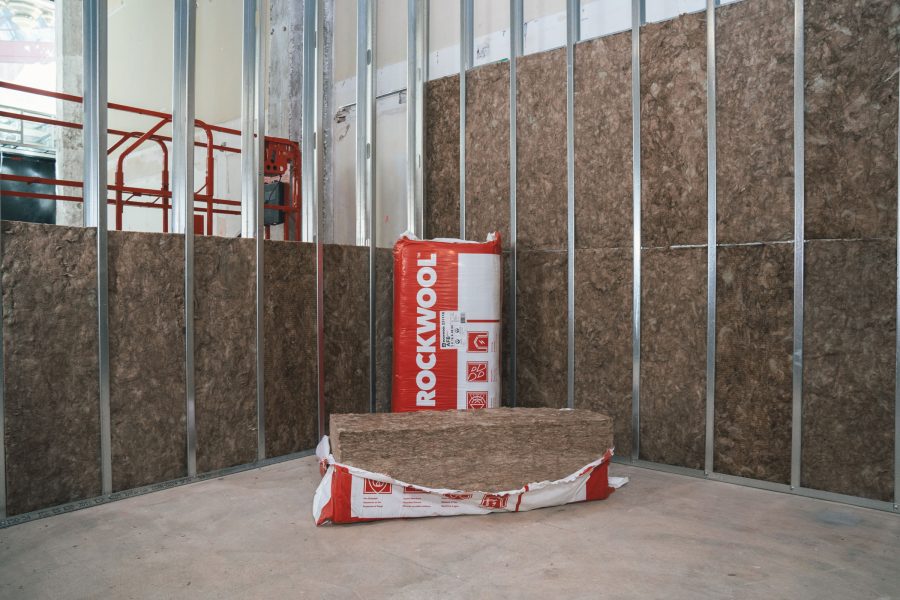Story at a glance:
- Manufacturers and architects share their perspectives on what to consider when choosing insulation for the environment and occupant health.
- Understanding the life cycle of the insulation product you choose can lower carbon emissions.
- Your choice of insulation largely depends on context and performance goals, like resilience and life safety.
Insulation is hidden from view of occupants, and while it may be considered a small part of a building’s construction, it has an outsized impact on comfort inside the building.
Insulation may also affect occupant health, with some materials releasing toxic chemicals during manufacturing, installation, and even long after installation. One must also consider the overall carbon impacts from the life cycle of the product, which have ramifications on the planet for years to come.
Choosing Insulation
Every type of insulation has its pros and cons in terms of how it performs and how it’s manufactured, installed, and eventually removed for waste or recycling. And not all insulation types can be used in every circumstance.
“Regional legislation matters a lot when choosing green materials,” says Kimberly Seigel, a research manager for Perkins&Will. “The secondary factor is also client-driven. Is the client inspired by sustainability? Do they have a mission or objectives around this? Do they have a building design plan for this themselves?”
Builders and architects may choose from plant-based products, fiberglass, mineral wool, XPS, and closed cell spray foams. Spray foam insulation, for example, is made of a combination of proprietary chemicals like surfactants and flame retardants that react together to create a foam that solidifies. Spray foam has some of the highest R-values, but the tradeoff is that the foam is flammable and can release toxic gases when burning.
The market is looking for insulation materials that enable low carbon design and limit impact to building occupants, often resulting in the search for alternatives to foam plastic insulations, according to Alejandra Nieto, sustainability manager at ROCKWOOL, the world’s largest stone wool insulation manufacturer. Nieto says project teams looking to increase energy efficiency and use non-combustible solutions should consider stone wool.
Selecting an insulation solely on its thermal resistance—or on any one single attribute is not best practice. “The effective thermal resistance of the entire assembly is of greater consequence to a building’s overall energy efficiency than the thermal resistance of the insulation alone,” Nieto says. “Importantly, the emissions associated with production of insulation are offset by operational energy savings typically seen within the first year of a building’s lifetime. This gives designers more flexibility when choosing insulation, allowing them to focus on key performance benefits like proven long-term performance and fire resistance properties.”
Understanding Stone Wool Insulation

Photo courtesy of Rockwool
Mineral wool insulation is made from molten rock, slag, or other minerals, which are subjected to high heat and spun into fibers. There are two types of mineral wool insulation—stone wool and slag wool. Stone wool is made primarily from basalt rock, one of the world’s most abundant resources. Both types of insulation materials can be found in various forms—like batts, board, and pipe insulation—making it suitable for diverse applications.
“We’re seeing a growing demand for stone wool insulation primarily because it is fire resistant and has a lower environmental impact,” Nieto says. “While used throughout the US, there’s an increased interest in regions with stringent fire regulations and areas that are prone to wildfires.” She says ROCKWOOL stone wool is tested and considered non-combustible, per ASTM. “It has built-in fire protection properties and is not dependent on chemical flame retardants.”
Specifying fire-rated assemblies and fire-resistant materials in the building envelope is a crucial component of the most effective strategy for limiting fire spread, Nieto says. Stone wool insulation, made from volcanic rock, can withstand temperatures exceeding 1000°C (1832°F) and is classified as non-combustible, according to ASTM E136. These properties make it an essential element in fire-resistant assemblies.
More Benefits
In addition to fire and thermal performance, stone wool insulation also has acoustical benefits, which contribute to indoor comfort and health. “Not all insulations perform equally when it comes to acoustics,” Nieto says. “When properly installed, stone wool insulation can significantly reduce the sound transmission in a wall assembly.”
Another key property of stone wool is water repellency and its ability to drain and dry. “Stone wool is defined as hydrophobic and water repellent, meaning it is engineered to prevent water from penetrating the surface and will not attract or absorb moisture from the surrounding environment,” Nieto says. In the event the insulation becomes wet, it will maintain its original performance characteristics when it is thoroughly dried if it is free from physical damage and contamination.
Insulation’s Impact on Occupants

ROCKWOOL Insulation goes up inside the AIA San Francisco Center for Architecture + Design. Photo courtesy of Rockwool
Insulation is not a one-and-done application when you consider its lifetime effects on inhabitants. In research conducted by Perkins&Will and Habitable (formerly Healthy Building Network), certain insulation materials, namely XPS and closed-cell spray foam, worsened air quality in the home over time for occupants.
Clearly understanding a product’s impact on occupant health is especially important when it comes to interior insulation. Compared to other types of insulation, mineral wool batts perform as well as fiberglass batts in terms of R-values, but some mineral wool applications may contain formaldehyde, and residual levels may be released from products during use, according to Habitable Insulation Product Guidance.
We need to ensure we incentivize the use of building materials that meet holistic sustainability goals.
Siegel suggests selecting mineral wool products that don’t have formaldehyde binders and avoiding the use of facers that contain chemicals, such as halogenated flame retardants according to Habitable, noting that it depends on why you’re choosing the product in the first place. If your primary aim is a non-combustible building, mineral wool is the best solution.
Stone wool insulation for interior partition walls is available with no added formaldehyde, Nieto says. “It is critical to consider the interplay between material health, its embodied carbon, and impact on occupant safety. As an industry we need to ensure we incentivize the use of building materials that meet holistic sustainability goals in addition to meeting long-term performance and fire safety requirements.”
Lowering Carbon Emissions
How insulation materials are made and recycled is another consideration. In Perkins&Will and Habitable’s “Embodied Carbon and Material Health in Insulation” report, prioritizing products that have Health Product Declarations (HPDs)—disclosures on any chemical concerns within an insulation material—and Environmental Product Declarations (EPDs), or documents that outline any environmental impacts a product may have, helps to address carbon emissions and health risks. They also suggest builders research manufacturers and buy from those who offer takeback programs for insulation waste when available.
When it comes to a product’s embodied carbon, full life cycle impact from manufacturing to end of life should be considered. For insulation materials, while most of the embodied carbon occurs during the manufacturing phase, in some cases, specifically in the case of insulations that contain certain blowing agents, a significant amount of carbon emissions can occur during the use phase. Nieto says insulation selection should also consider long-term stability, so you don’t have to replace the insulation to maintain performance.
“There’s a lot of room for innovation, a lot of room for growth,” Siegel says. “It’s not about how to make a wall assembly, though I encourage any architect to be as innovative as possible with wall assembly. But the impetus is on the building material manufacturer to create better materials.”
Nieto says ROCKWOOL has committed to reach net-zero greenhouse gas emissions by 2050. “This builds on the medium-term decarbonization goals we set in 2020 to reduce absolute Scope 1 and 2 GHG emissions by 38% and absolute Scope 3 emissions by 20%. To reach these goals ROCKWOOL is investing in new technologies to reduce the company’s carbon footprint,” she says.
Siegel says recycling is another consideration in overall selection. Sheep’s wool, cellulose, mineral wool, and fiberglass can be recycled or are made of a certain percentage of recycled materials.
But recycling programs can be limited, and there’s still a question of waste. For example, globally ROCKWOOL offers the Rockcycle initiative, collecting stone wool material from construction, renovation, and demolition sites to be reused in new ROCKWOOL products. Nieto says this facilitates a truly circular and closed loop recycling system. While stone wool insulation is particularly well suited to takeback programs, the lack of infrastructure and reverse logistics makes it a challenge to implement at scale, she says.
“Circularity is at the core of our sustainability strategy because of stone wool’s remarkable traits,” Nieto continues. “Two of the most important traits are its recyclability and durability.”
She points to stone wool as a solution that can be endlessly recycled, meaning it can be recycled again and again without degrading its quality. “Our stone wool can be recirculated back into our process to create new insulation. This helps reduce our overall waste going to landfills and our dependence on virgin raw materials.”
Laura Rote contributed to this reporting.

